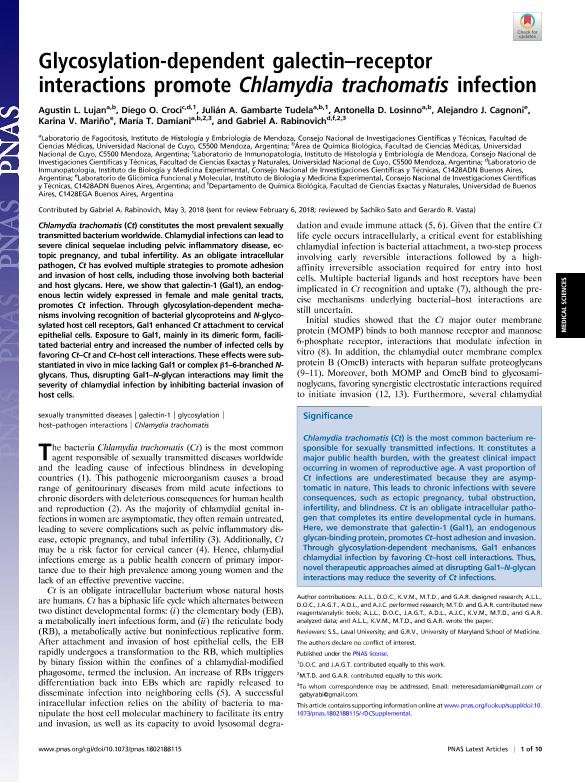Artículo
Glycosylation-dependent galectin-receptor interactions promote Chlamydia trachomatis infection
Lujan, Agustin Leonardo ; Croci Russo, Diego Omar
; Croci Russo, Diego Omar ; Gambarte Tudela, Julian Alberto
; Gambarte Tudela, Julian Alberto ; Losinno, Antonella Denise
; Losinno, Antonella Denise ; Cagnoni, Alejandro
; Cagnoni, Alejandro ; Mariño, Karina Valeria
; Mariño, Karina Valeria ; Damiani, María Teresa; Rabinovich, Gabriel Adrián
; Damiani, María Teresa; Rabinovich, Gabriel Adrián
 ; Croci Russo, Diego Omar
; Croci Russo, Diego Omar ; Gambarte Tudela, Julian Alberto
; Gambarte Tudela, Julian Alberto ; Losinno, Antonella Denise
; Losinno, Antonella Denise ; Cagnoni, Alejandro
; Cagnoni, Alejandro ; Mariño, Karina Valeria
; Mariño, Karina Valeria ; Damiani, María Teresa; Rabinovich, Gabriel Adrián
; Damiani, María Teresa; Rabinovich, Gabriel Adrián
Fecha de publicación:
26/06/2018
Editorial:
National Academy of Sciences
Revista:
Proceedings of the National Academy of Sciences of The United States of America
ISSN:
0027-8424
Idioma:
Inglés
Tipo de recurso:
Artículo publicado
Clasificación temática:
Resumen
Chlamydia trachomatis (Ct) constitutes the most prevalent sexually transmitted bacterium worldwide. Chlamydial infections can lead to severe clinical sequelae including pelvic inflammatory disease, ectopic pregnancy, and tubal infertility. As an obligate intracellular pathogen, Ct has evolved multiple strategies to promote adhesion and invasion of host cells, including those involving both bacterial and host glycans. Here, we show that galectin-1 (Gal1), an endogenous lectin widely expressed in female and male genital tracts, promotes Ct infection. Through glycosylation-dependent mechanisms involving recognition of bacterial glycoproteins and N-glycosylated host cell receptors, Gal1 enhanced Ct attachment to cervical epithelial cells. Exposure to Gal1, mainly in its dimeric form, facilitated bacterial entry and increased the number of infected cells by favoring Ct–Ct and Ct–host cell interactions. These effects were substantiated in vivo in mice lacking Gal1 or complex β1–6-branched N-glycans. Thus, disrupting Gal1–N-glycan interactions may limit the severity of chlamydial infection by inhibiting bacterial invasion of host cells.
Archivos asociados
Licencia
Identificadores
Colecciones
Articulos(IBYME)
Articulos de INST.DE BIOLOGIA Y MEDICINA EXPERIMENTAL (I)
Articulos de INST.DE BIOLOGIA Y MEDICINA EXPERIMENTAL (I)
Articulos(IHEM)
Articulos de INST. HISTOLOGIA Y EMBRIOLOGIA DE MEND DR.M.BURGOS
Articulos de INST. HISTOLOGIA Y EMBRIOLOGIA DE MEND DR.M.BURGOS
Citación
Lujan, Agustin Leonardo; Croci Russo, Diego Omar; Gambarte Tudela, Julian Alberto; Losinno, Antonella Denise; Cagnoni, Alejandro; et al.; Glycosylation-dependent galectin-receptor interactions promote Chlamydia trachomatis infection; National Academy of Sciences; Proceedings of the National Academy of Sciences of The United States of America; 115; 26; 26-6-2018; E6000-E6009
Compartir
Altmétricas



